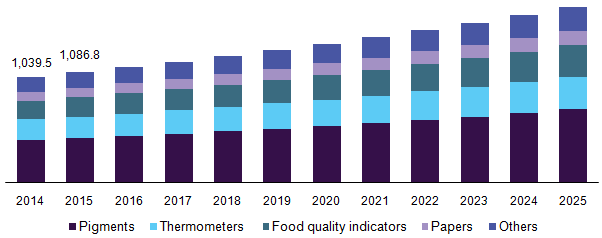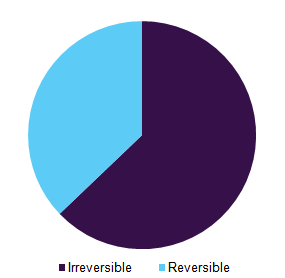- Home
- »
- Advanced Interior Materials
- »
-
Thermochromic Materials Market Size, Industry Report, 2018-2025GVR Report cover
![Thermochromic Materials Market Size, Share & Trends Report]()
Thermochromic Materials Market Size, Share & Trends Analysis Report By Product (Reversible, Irreversible), By Application (Food Quality Indicators, Papers, Pigments, Thermometers), By Region, And Segment Forecasts, 2018 - 2025
- Report ID: GVR-1-68038-866-4
- Number of Report Pages: 120
- Format: PDF, Horizon Databook
- Historical Range: 2014 - 2016
- Forecast Period: 2017 - 2025
- Industry: Advanced Materials
Industry Insights
The global thermochromic materials market size was valued at USD 4.77 billion in 2016. The growing demand for innovative products with temperature-based, color-changing abilities for entertainment or functional applications has contributed significantly to market growth in recent years.
The temperature-sensitive materials are being utilized in the form of inks, coatings, paper sheets, and polymers to manufacture practical products, which provide ease of access, amusement, and convenience to customers. Forehead strip thermometer is one such unique example of printed liquid crystals, which changes color to effectively indicate excessive body temperature during surgeries.
U.S. thermochromic materials market by application, 2014 - 2025 (USD Million)

Pigments accounted for a major share of the industry revenues in 2016. These are often printed onto plastic films and preferred over conventional dye systems, owing to their longevity, consistency, and high-performance efficiency. Pigments such as leuco dyes & liquid crystals have helped develop infrared camouflage for military assets and other functional areas.
Technological innovations such as the introduction of energy management construction films and the encapsulation of flexible electronics & OLED devices are a key driving aspect for the product. In addition, the growing demand in the textile industry is expected to complement product demand over the next eight years.
Application Insights
Pigments accounted for 41.0% of the overall thermochromic industry revenues in 2016, driven by their high versatility and improved performance characteristics. These pigments are often used in paints and inks, which are applied onto substrates to manufacture consumer goods. The development of unique pigments with enhanced color and lower costs is expected to augment the pigments segment during the forecast period.
Rising energy costs and global warming concerns have sparked the implementation of guidelines, promoting the need for solar management options for construction and architectural applications in Europe. Thermochromic pigments are thus being utilized to impart heat-control & color-changing abilities to windows, exterior walls, and other construction components.
There is a growing awareness among manufacturers of military equipment regarding pigments for camouflaging their sensitive devices from infrared detection. Furthermore, the use of thermochromic materials as food quality indicators to determine the quality of the frozen meat and foods is expected to bolster the market over the next eight years.
Product Insights
Reversible materials accounted for 37.2% of the overall revenue in 2016. These materials transition at a predetermined temperature threshold, which renders them ideal for sensory applications. These sensors aid in identifying the overheating hazards; as a result, the demand for reversible materials in sensors is high in chemical containers and baby products.
Reversible technology is preferred over irreversible technology. However, attaining reversibility by maintaining the stability of the solution is a complicated process, which has hampered its growth in the industry. However, the utilization of innovative and stable materials in consumer goods is expected to have a positive impact on the thermochromic materials market over the forecast period.
Global thermochromic materials market revenue by product, 2016 (%)

A reversible pigment-based apparel line has also been introduced for endurance athletes and other sports personnel to enable exhaustion detection. The Unseen, a London-based innovation company, has also launched reversible thermochromic hair dyes, which allow consumers to change their hair color on the basis of their surrounding environments.
Irreversible inks transition from an invisible, colorless stage to a permanent color palette when heated. This irreversible characteristic is utilized to produce flexographic screens, textiles, and other products. High demand for unique apparel, customizable with minimal effort, is expected to drive the demand for the irreversible pigments and other materials in the apparel market.
Regional Insights
The Asia Pacific is expected to be the fastest-growing region in terms of revenue over the forecast period. The increasing use of thermochromic pigments in the textile industry and manufacturing of novelty products, along with the high demand for the materials in the automotive industry in Japan, is expected to be the key aspect for the market growth in the region.
The demand for thermochromic food quality indicators in European countries is expected to drive the market growth for thermochromic materials in the region. The demand for these indicators to determine the quality of frozen meat and dairy products is expected to be the contributing factors for the demand for food quality indicators in the region.
The North American demand for the materials is driven by the increasing demand for thermochromic pigments in the U.S. for printing applications. The use of these pigments in inks for flexographic printing and screen printing is expected to be key aspects of the market growth in the region.
Thermochromic Materials Market Share Insights
The market is currently in a nascent stage, wherein most manufacturers are attempting to achieve full commercialization and realize profit margins. The industry is characterized by the presence of a few major players such as Olikrom and LCR Hallcrest, along with other new entrants who are competing to gain a foothold in the industry.
Technological innovations, intensive R&D, skimming pricing strategies, and collaborations are the key strategies being adopted by several small & medium-sized players to improve their current positions in the industry. This has led to significant development of processing & application technologies, equipment, raw materials, and other aspects of the market.
Report Scope
Attribute
Details
Base year for estimation
2016
Actual estimates/Historical data
2014 - 2016
Forecast period
2017 - 2025
Market representation
Volume in kilo tons; revenue in USD Million; and CAGR from 2017 to 2025
Regional scope
North America, Europe, Asia Pacific, Central & South America, and Middle East & Africa
Report coverage
Revenue forecast, company share, competitive landscape, growth factors and trends
15% free customization scope (equivalent to 5 analyst working days)
If you need specific market information, which is not currently within the scope of the report, we will provide it to you as a part of customization
Segments Covered in the ReportThis report forecasts revenue growth at global, regional & country levels and provides an analysis of the industry trends in each of the sub-segments from 2014 to 2025. For the purpose of this study, Grand View Research has segmented the global thermochromic materials market on the basis of product, application, and region:
-
Product Outlook (Volume, Kilo Tons; Revenue, USD Million; 2014 - 2025)
-
Reversible
-
Irreversible
-
-
Application Outlook (Volume, Kilo Tons; Revenue, USD Million; 2014 - 2025)
-
Food quality indicators
-
Papers
-
Pigments
-
Thermometers
-
Others
-
-
Regional Outlook (Volume, Kilo Tons; Revenue, USD Million; 2014 - 2025)
-
North America
-
The U.S.
-
-
Europe
-
Germany
-
The U.K.
-
-
Asia Pacific
-
China
-
India
-
Japan
-
-
Central & South America
-
Brazil
-
-
Middle East & Africa
-
Share this report with your colleague or friend.
![gvr icn]()
NEED A CUSTOM REPORT?
We can customize every report - free of charge - including purchasing stand-alone sections or country-level reports, as well as offer affordable discounts for start-ups & universities. Contact us now
![Certified Icon]()
We are GDPR and CCPA compliant! Your transaction & personal information is safe and secure. For more details, please read our privacy policy.
We are committed towards customer satisfaction, and quality service.
"The quality of research they have done for us has been excellent."





